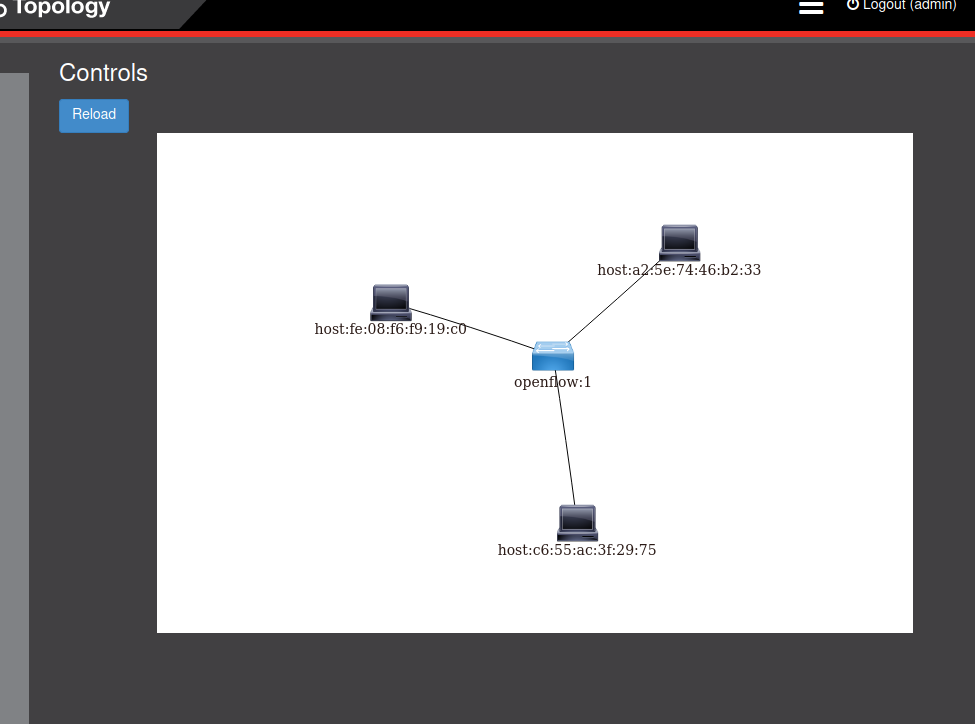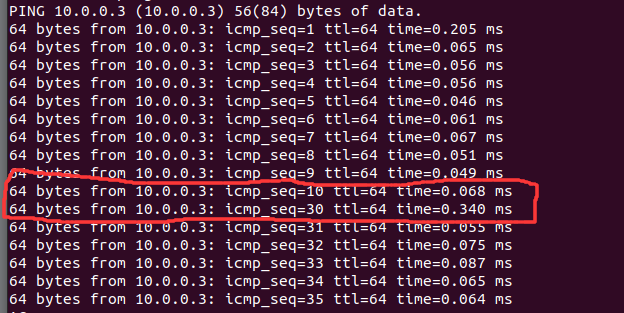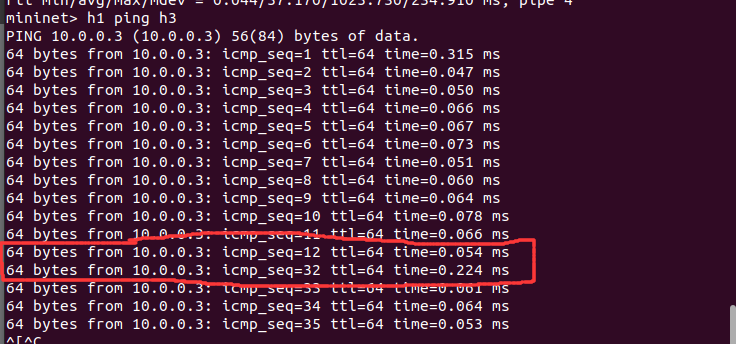实验7:基于REST API的SDN北向应用实践
(1) 利用Mininet平台搭建下图所示网络拓扑,并连接OpenDaylight;


(2) 编写Python程序,delet.py,调用OpenDaylight的北向接口下发指令删除s1上的流表数据。
点击查看代码
import requests
from requests.auth import HTTPBasicAuth
if __name__ == '__main__':
url = 'http://127.0.0.1:8181/restconf/operational/opendaylight-inventory:nodes/node/openflow:1/'
headers = {'Content-Type': 'application/json'}
response = requests.delete(url=url, headers=headers, auth=HTTPBasicAuth('admin', 'admin'))
print(response.content)

(3) 编写Python程序,调用OpenDaylight的北向接口下发硬超时流表,实现拓扑内主机h1和h3网络中断20s
.timeout.py
点击查看代码
#!/usr/bin/python
import requests
from requests.auth import HTTPBasicAuth
if __name__ == "__main__":
url = 'http://127.0.0.1:8181/restconf/config/opendaylight-inventory:nodes/node/openflow:1/flow-node-inventory:table/0/flow/1'
with open("./timeout.json") as file:
str = file.read()
headers = {'Content-Type': 'application/json'}
res = requests.put(url, str, headers=headers, auth=HTTPBasicAuth('admin', 'admin'))
print (res.content)
点击查看代码
{
"flow": [
{
"id": "1",
"match": {
"in-port": "1",
"ethernet-match": {
"ethernet-type": {
"type": "0x0800"
}
},
"ipv4-destination": "10.0.0.3/32"
},
"instructions": {
"instruction": [
{
"order": "0",
"apply-actions": {
"action": [
{
"order": "0",
"drop-action": {}
}
]
}
}
]
},
"flow-name": "flow",
"priority": "65535",
"hard-timeout": "20",
"cookie": "2",
"table_id": "0"
}
]
}


(4) 编写Python程序,get_flows.py,调用OpenDaylight的北向接口获取s1上活动的流表数。
点击查看代码
#!/usr/bin/python
import requests
from requests.auth import HTTPBasicAuth
def http_get(url):
url= url
headers = {'Content-Type':'application/json'}
resp = requests.get(url,headers=headers,auth=HTTPBasicAuth('admin','admin'))
return resp
if __name__ == "__main__":
url='http://127.0.0.1:8181/restconf/operational/opendaylight-inventory:nodes/node/openflow:1/flow-node-inventory:table/0/opendaylight-flow-table-statistics:flow-table-statistics'
resp = http_get(url)
print(resp.content)

2、编写Python程序,调用Ryu的北向接口实现以下功能
(1) 编写python程序实现上述OpenDaylight实验拓扑上相同的硬超时流表下发。
.ryu_timeout.py
点击查看代码
import requests
from requests.auth import HTTPBasicAuth
if __name__ == '__main__':
url = 'http://127.0.0.1:8080/stats/flowentry/add'
headers = {'Content-Type': 'application/json'}
json = open('ryu_timeout.json').read()
response = requests.post(url, data=json, headers=headers)
print(response.content)
.ryu_timeout.json
点击查看代码
{
"dpid": 1,
"cookie": 1,
"cookie_mask": 1,
"table_id": 0,
"hard_timeout": 20,
"priority": 65535,
"flags": 1,
"match":{
"in_port":1
},
"actions":[]
}


(2) 参考Ryu REST API的文档,基于VLAN实验的网络拓扑,编程实现相同的VLAN配置。
提示:拓扑生成后需连接Ryu,且Ryu应能够提供REST API服务

| VLAN_ID | HOST |
|---|---|
| 0 | h1、h3 |
| 1 | h2、h4 |
.根据VLAN实验的网络拓扑编写ryu_topo.py
点击查看代码
from mininet.topo import Topo
class ryu_topo(Topo):
def __init__(self):
Topo.__init__(self)
self.addSwitch("s1")
self.addSwitch("s2")
self.addHost("h1")
self.addHost("h2")
self.addHost("h3")
self.addHost("h4")
self.addLink("s1", "h1")
self.addLink("s1", "h2")
self.addLink("s2", "h3")
self.addLink("s2", "h4")
self.addLink("s1", "s2")
topos = {'ryu_topo': (lambda: ryu_topo())}
.编写符合vlan的set.py代码
点击查看代码
#!/usr/bin/python
import json
import requests
if __name__ == "__main__":
url = 'http://127.0.0.1:8080/stats/flowentry/add'
headers = {'Content-Type': 'application/json'}
flow1 = {
"dpid": 1,
"priority": 1,
"match":{
"in_port": 1
},
"actions":[
{
"type": "PUSH_VLAN",
"ethertype": 33024
},
{
"type": "SET_FIELD",
"field": "vlan_vid",
"value": 4096
},
{
"type": "OUTPUT",
"port": 3
}
]
}
flow2 = {
"dpid": 1,
"priority": 1,
"match":{
"in_port": 2
},
"actions":[
{
"type": "PUSH_VLAN",
"ethertype": 33024
},
{
"type": "SET_FIELD",
"field": "vlan_vid",
"value": 4097
},
{
"type": "OUTPUT",
"port": 3
}
]
}
flow3 = {
"dpid": 1,
"priority": 1,
"match":{
"vlan_vid": 0
},
"actions":[
{
"type": "POP_VLAN",
"ethertype": 33024
},
{
"type": "OUTPUT",
"port": 1
}
]
}
flow4 = {
"dpid": 1,
"priority": 1,
"match": {
"vlan_vid": 1
},
"actions": [
{
"type": "POP_VLAN",
"ethertype": 33024
},
{
"type": "OUTPUT",
"port": 2
}
]
}
flow5 = {
"dpid": 2,
"priority": 1,
"match": {
"in_port": 1
},
"actions": [
{
"type": "PUSH_VLAN",
"ethertype": 33024
},
{
"type": "SET_FIELD",
"field": "vlan_vid",
"value": 4096
},
{
"type": "OUTPUT",
"port": 3
}
]
}
flow6 = {
"dpid": 2,
"priority": 1,
"match": {
"in_port": 2
},
"actions": [
{
"type": "PUSH_VLAN",
"ethertype": 33024
},
{
"type": "SET_FIELD",
"field": "vlan_vid",
"value": 4097
},
{
"type": "OUTPUT",
"port": 3
}
]
}
flow7 = {
"dpid": 2,
"priority": 1,
"match": {
"vlan_vid": 0
},
"actions": [
{
"type": "POP_VLAN",
"ethertype": 33024
},
{
"type": "OUTPUT",
"port": 1
}
]
}
flow8 = {
"dpid": 2,
"priority": 1,
"match": {
"vlan_vid": 1
},
"actions": [
{
"type": "POP_VLAN",
"ethertype": 33024
},
{
"type": "OUTPUT",
"port": 2
}
]
}
res1 = requests.post(url, json.dumps(flow1), headers=headers)
res2 = requests.post(url, json.dumps(flow2), headers=headers)
res3 = requests.post(url, json.dumps(flow3), headers=headers)
res4 = requests.post(url, json.dumps(flow4), headers=headers)
res5 = requests.post(url, json.dumps(flow5), headers=headers)
res6 = requests.post(url, json.dumps(flow6), headers=headers)
res7 = requests.post(url, json.dumps(flow7), headers=headers)
res8 = requests.post(url, json.dumps(flow8), headers=headers)


三.进阶要求
OpenDaylight或Ryu任选其一,编程实现查看前序VLAN实验拓扑中所有节点(含交换机、主机)的名称,以及显示每台交换机的所有流表项。
(1)get.py
点击查看代码
import requests
import time
import re
class GetInformation:
def __init__(self, ip):
self.ip = ip
def get_switch_id(self):
url = 'http://' + self.ip + '/stats/switches'
re_switch_id = requests.get(url=url).json()
switch_id_hex = []
for i in re_switch_id:
switch_id_hex.append(hex(i))
return switch_id_hex
def get_flow_table(self):
url = 'http://' + self.ip + '/stats/flow/%d'
list_switch = self.get_switch_id()
all_flow = []
for switch in list_switch:
new_url = format(url % int(switch, 16))
re_switch_flow = requests.get(url=new_url).json()
all_flow.append(re_switch_flow)
return all_flow
def show_flow(self):
list_flow = self.get_flow_table()
for flow in list_flow:
for dpid in flow.keys():
dp_id = dpid
print('switch_name:s{1}'.format(hex(int(dp_id)), int(dp_id)))
for list_table in flow.values():
for table in list_table:
print(table)
def show_name(self):
list_flow = self.get_flow_table()
for flow in list_flow:
for dpid in flow.keys():
dp_id = dpid
switchnum= '{1}'.format(hex(int(dp_id)), int(dp_id))
print('s'+switchnum)
switchnum = int(switchnum)
for list_table in flow.values():
count = 0
for table in list_table:
string1 = str(table)
if re.search("'dl_vlan': '(.*?)'", string1) is not None:
num = re.search("'dl_vlan': '(.*?)'", string1).group(1);
if num == '0' and switchnum == 1:
print('h1')
if num == '1' and switchnum == 1:
print('h2')
if num == '0' and switchnum == 2:
print('h3')
if num == '1' and switchnum == 2:
print('h4')
S1 = GetInformation("127.0.0.1:8080");
S1.show_name();
S1.show_flow();

四.个人总结
本次实验我学到了编写程序调用OpenDaylight REST API和Ryu REST API实现特定网络功能。本次实验的编写程序对我来说比较困难。用到了之前OpenDaylight和Ryu的相关知识,经过复习才顺利完成。经过这次实验,我大致了编写程序调用OpenDaylight REST API和Ryu REST API实现特定网络功能。重新回顾PDF文档熟悉了相关控制器的使用,对控制器的启动,下发流表等操作更熟悉了,并且在实践中通过阅读相关文档,查阅资料,了解到了北向接口API其实并没有一个统一的标准,不同的控制器对应着的API也有所区别,体会到了SDN框架的灵活性和可编程性。实验的第一部分总体比较简单,使我困惑的地方在配置vlan时无法实现,删除流表的工具也出了问题,最后改了代码发现不需要删除流表,代码有所参考,实验的第二部分有一定难度,有所参考后最终解决了问题



 浙公网安备 33010602011771号
浙公网安备 33010602011771号